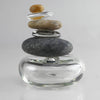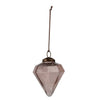Welcome to the illuminating world of glass art, where beauty and colors come alive in the hands of skilled artisans. At Art Glass Haven, we celebrate not only the rich history of this splendid art form but also its vibrant future through sustainable practices and the promotion of local artisans. Join us as we delve into the intriguing processes, tools, and stories that make this medium uniquely captivating.
Exploring the Techniques
The art of glassmaking is both an ancient craft and a modern expression of artistic vision, where every technique requires a blend of creativity and precision. Here's a deeper dive into the primary techniques used by our artists at Art Glass Haven, each bringing its unique flair to the pieces we create:
Blowing

Glass blowing is a dynamic technique that dates back to around the 1st century BC. An artisan begins with a glob of molten glass at the end of a blowpipe and inflates it by blowing air through the pipe, much like blowing up a balloon. Throughout the process, the glass is heated repeatedly in the glory hole (a high-temperature furnace) to maintain its malleability. The artisan manipulates the shape by swinging, rolling, and shaping the glass using tools like jacks, shears, and blocks. This technique is particularly revered for creating beautiful vessels, intricate light fixtures, and ornamental spheres, each piece bearing the breath of its creator.
SHOP NEW BLOWN GLASS ITEMS
Fusing
Fusing involves stacking or layering thin sheets, rods, and pieces of glass, which are then placed inside a kiln to melt (fuse) together. The glass fusion process can reach temperatures up to 1500 degrees Fahrenheit. This method allows for vibrant, multi-colored patterns and can be used to create everything from artistic plates and coasters to large-scale glass murals. Fusing can also incorporate other elements such as metal inclusions and dichroic glass, adding shimmer and depth to the pieces.
SHOP NEW FUSED GLASS ITEMS
Flameworking

Flameworking, also known as lampworking, is a meticulous glass technique that involves shaping glass using a torch. The artist heats glass rods or tubes in a flame until they become malleable, then uses tools like tweezers and marvers to mold and detail the piece.
This method is particularly favored for its precision and control, which are ideal for creating detailed beads, jewelry, and miniature sculptures. Flameworking allows artists to work with colored glass, layering and blending hues to produce vibrant patterns directly within the glass. Unlike other glassmaking techniques that require large furnaces, flameworking can be performed in smaller, more personal studio spaces, enhancing its appeal among artists who value intricate detail and personal expression in their work.
SHOP NEW FLAMEDWORKED GLASS ITEMS
Casting
Glass casting is a method where molten glass is poured into a mold where it solidifies into the desired shape. This technique is ideal for creating sculptural pieces and detailed figurative works that would be difficult or impossible to achieve with blowing or fusing, and in more production or industrial shops blowing large quantities of items. The molds can be made from various materials including sand, plaster, and graphite, each providing different textures and details to the glass. Casting is a preferred method for artists looking to create large, solid pieces that require intricate designs and substantial volume, such as statues or large decorative elements, and production processes.
Coldworking
Coldworking refers to the techniques used on glass after it has been formed and cooled. This includes cutting, grinding, sandblasting, and polishing. Coldworking is crucial for refining the final piece, adding details, and achieving the precise finish that makes each piece a masterpiece. Cutting can be used to create facets or edges, while grinding smooths out any imperfections. Sandblasting is a technique used to matte the surface of the glass for a frosted look, and polishing brings out the glass’s inherent luminosity. Coldworking is essential for adding the finishing touches that enhance the visual and tactile qualities of the glass.
Tools of the Artisan

The creation of glass art is supported by a variety of specialized tools that help our artists achieve precision and beauty. From the furnace, where glass is heated to an astonishing 2,400 degrees Fahrenheit, to the kilns where it is carefully annealed, each tool plays a crucial role in the life of a glasswork:
- Kilns: Crucial for processes like fusing and slumping, our kilns are meticulously controlled to ensure perfect temperature management.
- Blowpipes and Punty Rods: Essential for glassblowing, these tools allow artisans to shape molten glass into desired forms.
- Molds: Used in casting, molds can be made from various materials and help in achieving intricate details and consistent shapes.
These tools are not just instruments but extensions of the artisans' hands, each marking its influence on the glass, from raw shape to finished beauty.
One Artisan’s Journey
One of our celebrated artists, Kara Gunter of Tommy Gun Glass, exemplifies the passion and dedication behind our artistry. In her profile on our blog, Kara describes her journey into glassmaking, her inspiration drawn from natural forms, and her personal philosophy that guides her unique designs. Her work with recycled and environmentally friendly materials is a testament to our commitment to sustainability and ethical art production. Read more about Kara’s journey and artistic philosophy here.
Why Choose Art Glass Haven
Choosing Art Glass Haven means more than acquiring a piece of glass art; it means supporting an eco-friendly and ethically conscious community that values the preservation of craft and culture. Our commitment to sustainability is woven through every stage of production, from sourcing recycled glass materials to employing energy-efficient techniques in our workshops.
Moreover, each purchase contributes not just to the livelihood of local artisans but also to the cultural preservation of glassmaking as an art form. By choosing handcrafted pieces, our customers help maintain artistic diversity and support a tradition of creativity and manual skill that is increasingly rare in our automated world.
Conclusion
Behind every piece of glass art at Art Glass Haven is a story of passion, precision, and sustainability. We invite you to become part of this story—a tale woven through generations, colored with the earth’s own materials, and shaped by the fires of imagination.
Explore our collections, learn more about our artists, and join our community by exploring Art Glass Haven. Here, beauty is more than what meets the eye; it’s a commitment to a more beautiful world.






















